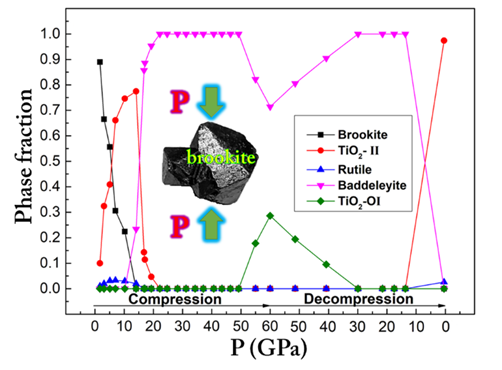Diverse Phase Changes of Natural bulk Brookite - Dr. Hengzhong Zhang
APRIL 18, 2019
New work from a team of scientists led by Dr. Hengzhong Zhang at HPSTAR probed the phase variation of natural bulk brookite under compression. They revealed how pressure medium affect the phase transition behavior of brookite. This study may be used for inferring the geological fate of brookite in nature. The work is published in ACS Earth and Space Chemistry.
There are three main natural forms of titania on the earth, anatase, brookite,and rutile,. Rutile is the most stable phase, whereas anatase and brookite are metastable phases and change to rutile when they are heated at higher temperatures.
Most of the previous studies has been focused on rutile and anatase, while brookite has been rarely been studied because of its complicated structure and challenge to synthesize in its pure form, especially the bulk phase.
However, such knowledge is needed to understand the formation mechanism, phase stability and possible fate of brookite minerals in nature.
The team of HPSTAR scientists focused on the high pressure phase evolution of the bulk brookite titania.They studied how the structure change of bulk brookite up to about 60 gigapascals.
The team used synchrotron HP-XRD and HP-Raman spectroscopy to investigate the phase transitions of natural bulk brookite in different pressure transmitting media and explored the medium effects on the transitions.

They found that natural bulk brookite undergoes a series of phase transitions at room temperature and under compression up to ~ 60 gigapascals. In three different pressure media, helium, neon, and methanol-ethanol mixture, brookite exhibits similar transition behaviors at pressures below ~ 21 gigapascals. However, above ~ 21 gigapascals, the phase behaviors became different in the three pressure medias — three distinct phase transition pathways up to the highest pressure in this study.
“The differences in the phase transitions above may arise from the differences in the non-hydrostaticity or the differential stress of the pressure medias after their solidification”, explained Dr. Henghzhong Zhang. “For brookite, the non-hydrostaticity of a pressure medium at high pressure can make the transition energetically less favorable than at hydrostatic conditions”.
“Our study provides new knowledge of the natural brookite phase transitions at very high pressures (up to ∼60 gigapascals), offering insights into how hydrostaticity and the elastic properties of a pressure medium can affect the phase transition behavior under compression”, added Dr. Hengzhong Zhang. “The obtained fundamental understanding of the brookite system may be transferable to other natural mineral systems”.
Caption: Phase contents of titania phases during compression and decompression of a natural brookite sample in a methanol-ethanol pressure medium.
天然二氧化钛主要以金红石,锐钛矿和板钛矿存在。目前尽管已有许多关于纳米晶二氧化钛以及体相锐钛矿和金红石的高压研究,但人们对体相板钛矿在高压下的相行为依然缺乏了解。 然而,人们需要这样的知识来了解自然界中板钛矿的形成机制、相稳定性和预测其在地球内部的存在形式。为此,北京高压科学研究中心张衡中研究员带领的研究小组对不同传压介质下体相板钛矿进行了高压相变研究。他们发现在氦、氖和甲乙醇混合物(4:1)三种传压介质中在压力小于21 GPa时, 板钛矿的相行为基本相同。然而,在压力从21 GPa到60 GPa之间,二氧化钛则表现出不同的相行为,而这些差别乃源于这些传压介质在其剪切模量和静水压性质上的差异。这些发现有助于人们了解自然界中板钛矿矿物的形成机制、相稳定性和可能的地球内部的存在形式。
